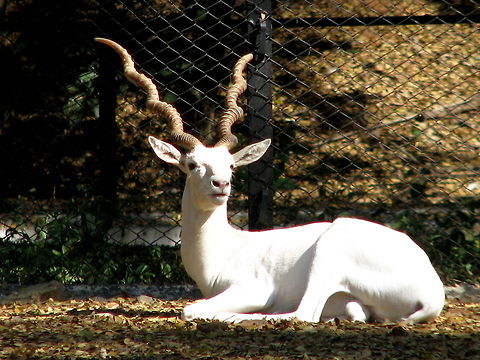
Appearance
Blackbucks are slender with a head-to-body length of about 120 cm . They are about 73.7 to 83.8 cm high at the shoulder. Males are larger than females. Adult males range in weight from 34 to 45 kg ; females weigh 31 to 39 kg . The tail is short and compressed. Both sexes are white on the belly, around the eyes and on the inside of the legs. They differ in the coloration of the head and back. Female and young blackbucks are yellowish-fawn coloured on the back and on the outside of the limbs; the lower parts are white. The two colours are sharply divided by a distinct pale lateral band. Old male bucks are blackish brown on the back, on the sides and front of the neck. They become almost black with age, only the nape remains brownish rufous, and the pale lateral band disappears. Only males have horns that are diverging, cylindrical, spiral, and ringed throughout. The rings are closer together near the skull. The turns of the spiral vary from less than 3 to 5.Horns are 45.6–68.5 cm long.
Horns can be as long as 71 cm . Blackbucks closely resemble kobs.
Albinism in blackbuck is rare and caused by the lack of the pigment melanin. Wildlife experts say the biggest problem with these albinos is they are singled out by predators and hunted.
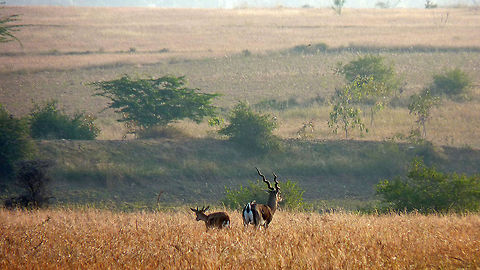
Distribution
In the 19th century, blackbucks ranged in open plains from the base of the Himalayas to the neighbourhood of Cape Comorin, and from the Punjab to Lower Assam. They were abundant in the North-Western Provinces, Rajputana, parts of the Deccan, and on the plains near the coast of Orissa and Lower Bengal. Herds occasionally comprised several thousand animals of both sexes and all ages.Today, the blackbuck population is confined to areas in Maharashtra, Odisha, Punjab, Rajasthan, Haryana, Gujarat, Andhra Pradesh, Tamil Nadu and Karnataka, with a few small pockets in central India. They occur in several protected areas of India including:
⤷ Velavadar National Park – is home to a large population estimated at 1500 individuals in the mid-1990s.
⤷ Point Calimere Wildlife and Bird Sanctuary
⤷ Tal Chhapar Sanctuary
⤷ National Chambal Sanctuary
⤷ Keoladeo National Park
⤷ Ranebennur Wildlife Sanctuary
⤷ Great Indian Bustard Sanctuary
⤷ Kaimur Wildlife Sanctuary
⤷ Gir Forest National Park
⤷ Guindy National Park
⤷ Ranthambhore National Park
In Nepal, the last surviving population of blackbuck is found in the Blackbuck Conservation Area south of the Bardia National Park. In 2008, the population was estimated at 184.
In Pakistan, blackbucks are irregular vagrants moving along the border areas with India. They are kept in enclosures in the Lal Suhanra National Park for possible reintroduction. They are considered extinct in Bangladesh.
Two subspecies are recognized:
⤷ ''A. c. cervicapra''
⤷ ''A. c. rajputanae''
Blackbucks were introduced to Argentina and the USA. These populations numbered about 43,600 individuals at the turn of the century.
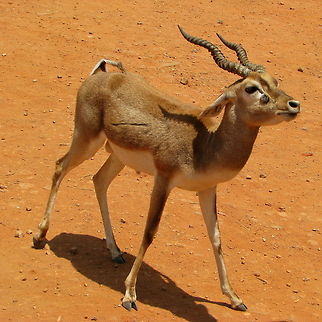
Status
In India, hunting of blackbucks is prohibited under the Wildlife Protection Act of 1972.Blackbucks can be seen in zoos.
Blackbucks are protected in
⤷ Abohar Wildlife Sanctuary, Punjab
⤷ Bagdara Wildlife Sanctuary, Madhya Pradesh
⤷ Indian Institute of Technology Madras, Tamil Nadu
⤷ Indian Wild Ass Sanctuary, Gujarat
⤷ Kanha National Park, Madhya Pradesh
⤷ Kirthar National Park, Pakistan
⤷ Jayamangali Blackbuck Reserve, Karnataka
⤷ Mahavir Harina Vanasthali National Park, Andhra Pradesh
⤷ Rehakuri Sanctuary, Maharashtra
⤷ Sathyamangalam Wildlife Sanctuary, Tamil Nadu
⤷ Vallanad Blackbuck Sanctuary, Tamil Nadu
They are also found in open areas near Dindori, Madhya Pradesh at Karopani Black Buck Conservation Area, which is located about 15 km from Dindori and also near Koppal in Koppal District about 15km from its headquarter.In Balaghat lane, Kolar Gold Field black bucks are found in unprotected area.
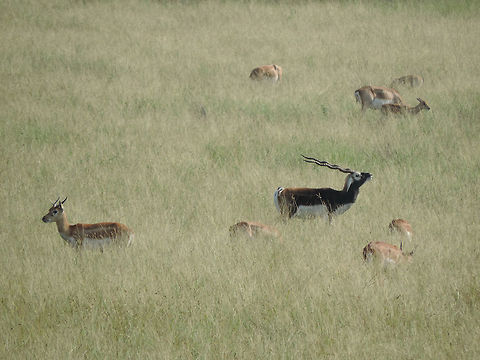
Behavior
Blackbucks generally live on open plains in herds of 5 to 50 animals with one dominant male. They are very fast. Speeds of more than 80 km/h have been recorded.They are primarily grazers and avoid forested areas. They require water every day and may move long distances in search of water and forage in summer. Usually, they feed during the day. Their diet consists mostly of grasses, but they have occasionally been observed browsing on acacia trees in the Cholistan Desert. In the Velavadar National Park, they were observed feeding on pods of ''Prosopis juliflora'' during seasonal lows in forage quality.
Their chief predator was the now extinct Asiatic cheetah. Currently, wolves are the main predators of both fawns and adults. Fawns are also hunted by jackals. Village dogs are reported to kill fawns but are unlikely to successfully hunt and kill adults.
The maximum life span recorded is 16 years and the average is 12 years.
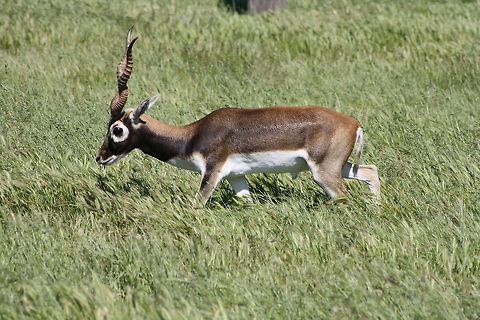
Habitat
In the 19th century, blackbucks ranged in open plains from the base of the Himalayas to the neighbourhood of Cape Comorin, and from the Punjab to Lower Assam. They were abundant in the North-Western Provinces, Rajputana, parts of the Deccan, and on the plains near the coast of Orissa and Lower Bengal. Herds occasionally comprised several thousand animals of both sexes and all ages.Today, the blackbuck population is confined to areas in Maharashtra, Odisha, Punjab, Rajasthan, Haryana, Gujarat, Andhra Pradesh, Tamil Nadu and Karnataka, with a few small pockets in central India. They occur in several protected areas of India including:
⤷ Velavadar National Park – is home to a large population estimated at 1500 individuals in the mid-1990s.
⤷ Point Calimere Wildlife and Bird Sanctuary
⤷ Tal Chhapar Sanctuary
⤷ National Chambal Sanctuary
⤷ Keoladeo National Park
⤷ Ranebennur Wildlife Sanctuary
⤷ Great Indian Bustard Sanctuary
⤷ Kaimur Wildlife Sanctuary
⤷ Gir Forest National Park
⤷ Guindy National Park
⤷ Ranthambhore National Park
In Nepal, the last surviving population of blackbuck is found in the Blackbuck Conservation Area south of the Bardia National Park. In 2008, the population was estimated at 184.
In Pakistan, blackbucks are irregular vagrants moving along the border areas with India. They are kept in enclosures in the Lal Suhanra National Park for possible reintroduction. They are considered extinct in Bangladesh.
Two subspecies are recognized:
⤷ ''A. c. cervicapra''
⤷ ''A. c. rajputanae''
Blackbucks were introduced to Argentina and the USA. These populations numbered about 43,600 individuals at the turn of the century.Blackbucks generally live on open plains in herds of 5 to 50 animals with one dominant male. They are very fast. Speeds of more than 80 km/h have been recorded.
They are primarily grazers and avoid forested areas. They require water every day and may move long distances in search of water and forage in summer. Usually, they feed during the day. Their diet consists mostly of grasses, but they have occasionally been observed browsing on acacia trees in the Cholistan Desert. In the Velavadar National Park, they were observed feeding on pods of ''Prosopis juliflora'' during seasonal lows in forage quality.
Their chief predator was the now extinct Asiatic cheetah. Currently, wolves are the main predators of both fawns and adults. Fawns are also hunted by jackals. Village dogs are reported to kill fawns but are unlikely to successfully hunt and kill adults.
The maximum life span recorded is 16 years and the average is 12 years.
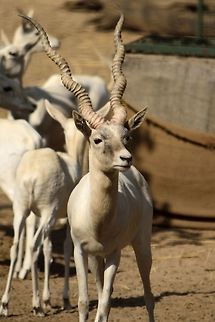
Predators
The main threats to the species are poaching, predation, habitat destruction, overgrazing, diseases, inbreeding and sanctuary visitors.Large herds once roamed freely on the plains of North India, where they thrived best. During the 18th, 19th and the first half of the 20th centuries, blackbuck was the most hunted wild animal all over India. Until India's independence in 1947, many princely states hunted this antelope and Indian gazelle, the chinkara, with specially trained captive Asiatic cheetahs. It once was one of the most abundant hoofed mammals in the Indian Subcontinent, so much so that as late as early 1900s, naturalist Richard Lydekker mentioned herds of hundreds in his writings. Today, only small herds are seen, largely inside reserves. The chief cause of their decline is excessive hunting. Though the royal sport had ended, farmers of the expanding areas of cultivation saw it as crop-raider, further leading to its decline. Eventually, when in the 1970s, several areas reported their extinction, it was listed as a protected animal under the Wildlife Protection Act of 1972.
The blackbuck is hunted for its flesh and its skin. Although Indian law strictly prohibits the hunting of these endangered animals, occasional incidents of poaching still occur. The remaining populations are under threat from inbreeding. The natural habitat of the blackbuck is being encroached upon by man's need for arable land and grazing ground for domesticated cattle. Exposure to domesticated cattle also exposes them to bovine diseases.
Its protected status has gained publicity through a widely reported court case, in which one of India's leading film stars, Salman Khan, was sentenced to five years imprisonment for killing two blackbucks and several endangered chinkaras. The arrest was prompted by intense protests from the Bishnoi ethnic group, which holds animals and trees sacred, and on whose land the hunting had taken place.
In another notorious incident of criminal poaching, Mansoor Ali Khan Pataudi also killed a blackbuck, and then absconded as a fugitive. He finally surrendered only when the case was transferred from the criminal court to a special environment court, where he would face lighter sentencing.
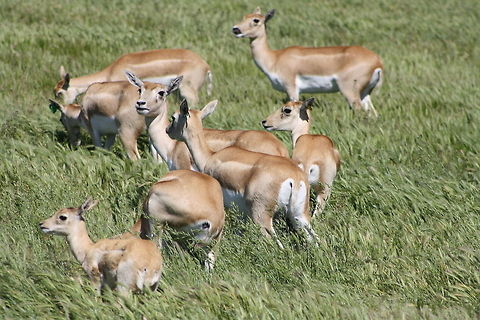
Cultural
The blackbuck is known by various names such as ''pulvaai'', ''thirugumaan'', ''velimaan'', ''kadamaan'', ''iralai'', ''karinchikedai'' and ''murugumaan'' in Tamil. It is also known as ''Krishna Mruga'' in Kannada and as ''Krishna Jinka'' in Telugu, it has been declared as the state animal of Andhra Pradesh. Other local names for the species include ''Krishnasar'' in Bengali, ''Kala Hiran, Sasin, Iralai Maan'', and'' Kalveet ''in Marathi. It is often simply called Indian antelope, though this term might also be used for other Antilopinae from the region.The skin of ''Krishna Mrugam'' plays an important role in Hinduism, and Brahmin boys are traditionally required to wear a strip of unleathered hide after performing Upanayanam. According to the Hindu mythology blackbuck or ''Krishna Jinka'' is considered as the vehicle of the Moon-god ''Chandrama''. According to the Garuda Purana of Hindu mythology, ''Krishna Jinka'' bestows prosperity in the areas where they live.
References:
Some text fragments are auto parsed from Wikipedia.